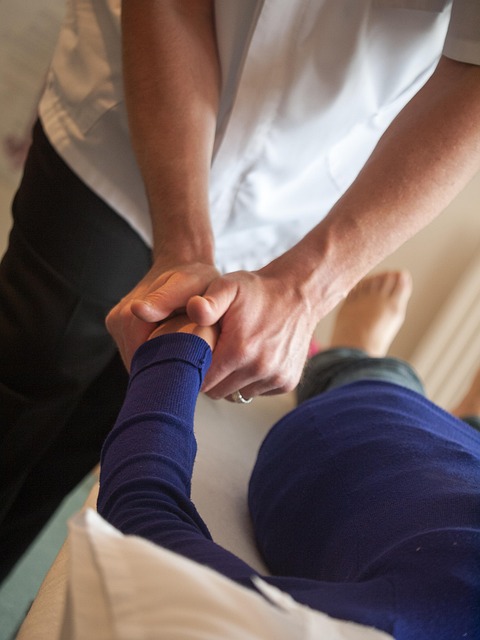Contrast therapy, an ancient practice using hot and cold temperatures, effectively aids muscle recovery and tendon/ligament health. Heat increases blood flow, delivering nutrients for repair while cold reduces inflammation. Regular sessions improve flexibility, strengthen tissues, and speed up post-workout recovery, benefiting athletes and fitness enthusiasts. Incorporating contrast therapy after intense workouts can significantly enhance muscle recovery and overall performance.
Discover the power of contrast therapy as a natural approach to enhance tendon and ligament health, accelerating muscle recovery post-workout. This ancient practice involves alternating between hot and cold stimuli to stimulate blood flow and reduce inflammation. By understanding the science behind it, you’ll unlock its potential benefits: improved healing rates and increased flexibility. Incorporate this simple yet effective technique into your routine for optimal muscular well-being.
Understanding Contrast Therapy: A Natural Approach to Muscle Recovery
Contrast therapy, an ancient practice with roots in traditional medicine, has gained modern popularity as a natural approach to muscle recovery and overall tendon and ligament health. This therapeutic method involves alternating between hot and cold temperatures to stimulate blood flow and promote healing. By immersing yourself in contrasting temperatures—such as soaking in hot water and then applying ice—you can effectively reduce inflammation, ease muscle soreness, and speed up the recovery process.
This simple yet powerful technique works by dilating blood vessels during heat exposure, increasing circulation and delivering essential nutrients to tired, overused muscles. The subsequent cold treatment causes vasoconstriction, reducing swelling and minimizing further damage. Regular contrast therapy sessions can enhance flexibility, strengthen connective tissues, and improve overall athletic performance, making it a valuable tool for athletes, fitness enthusiasts, and anyone seeking natural relief from muscle-related discomfort.
The Science Behind Contrast Therapy and Its Impact on Tendons and Ligaments
Contrast therapy, an ancient practice with modern scientific backing, has gained recognition as a powerful tool for muscle recovery and tissue healing, particularly focusing on tendons and ligaments. This therapeutic approach involves alternating between hot and cold treatments, stimulating various physiological responses in the body. When you immerse yourself in hot water, blood vessels dilate, increasing blood flow to the treated area. This enhanced circulation brings essential nutrients and oxygen, crucial for tendon and ligament repair and strengthening. Conversely, cold therapy causes vasoconstriction, reducing inflammation and slowing down metabolic processes, which can aid in pain relief and minimizing tissue damage.
The impact of contrast therapy on these connective tissues is profound. It promotes angiogenesis, the formation of new blood vessels, which is essential for delivering oxygen and nutrients to facilitate healing. Additionally, contrast baths can reduce muscle stiffness and spasms, improve range of motion, and accelerate the recovery process after intense physical activities or injuries. Many athletes and fitness enthusiasts incorporate contrast therapy into their routines as a natural way to enhance performance and expedite post-workout recovery, ensuring healthier tendons and ligaments over time.
Benefits for Tendon and Ligament Health: Improved Healing and Flexibility
Contrast therapy, involving alternating hot and cold treatments, offers significant advantages for tendon and ligament health, fostering improved healing and flexibility. By exposing muscles to varying temperatures, blood flow patterns change, enhancing circulation to the affected areas. Increased blood flow brings essential nutrients and oxygen, crucial for muscle repair and regeneration, while removing metabolic waste products that can hinder healing.
This therapeutic approach not only accelerates the recovery process but also improves tissue elasticity. The heat relaxes tight muscles and increases joint range of motion, while cold contractions stimulate blood vessels, reducing inflammation and strengthening connective tissues. Consequently, contrast therapy is an effective tool for athletes or anyone seeking to optimize tendon and ligament health, ensuring faster rehabilitation and enhanced performance.
Incorporating Contrast Therapy into Your Post-Workout Routine
After an intense workout, incorporating contrast therapy into your post-routine can significantly enhance muscle recovery. This involves alternating between hot and cold treatments, such as immersing yourself in a hot bath followed by a quick cold shower. The heat increases blood flow to your muscles, promoting the delivery of oxygen and nutrients for repair while reducing inflammation. In contrast, the cold helps constrict blood vessels, minimizing swelling and further reducing inflammation.
By integrating this simple yet effective technique into your post-workout regimen, you can experience faster recovery times, decreased soreness, and improved overall tendon and ligament health. It’s a quick, affordable, and accessible way to take care of your body, ensuring that you’re ready for your next training session with renewed strength and flexibility.
Contrast therapy, a natural approach to muscle recovery, offers significant benefits for tendon and ligament health. By alternating between hot and cold temperatures, this method enhances blood flow, speeds up healing processes, and improves flexibility. Incorporating contrast therapy into your post-workout routine can be a game-changer for achieving optimal tendon and ligament health. Give it a try and experience the positive effects for yourself!
